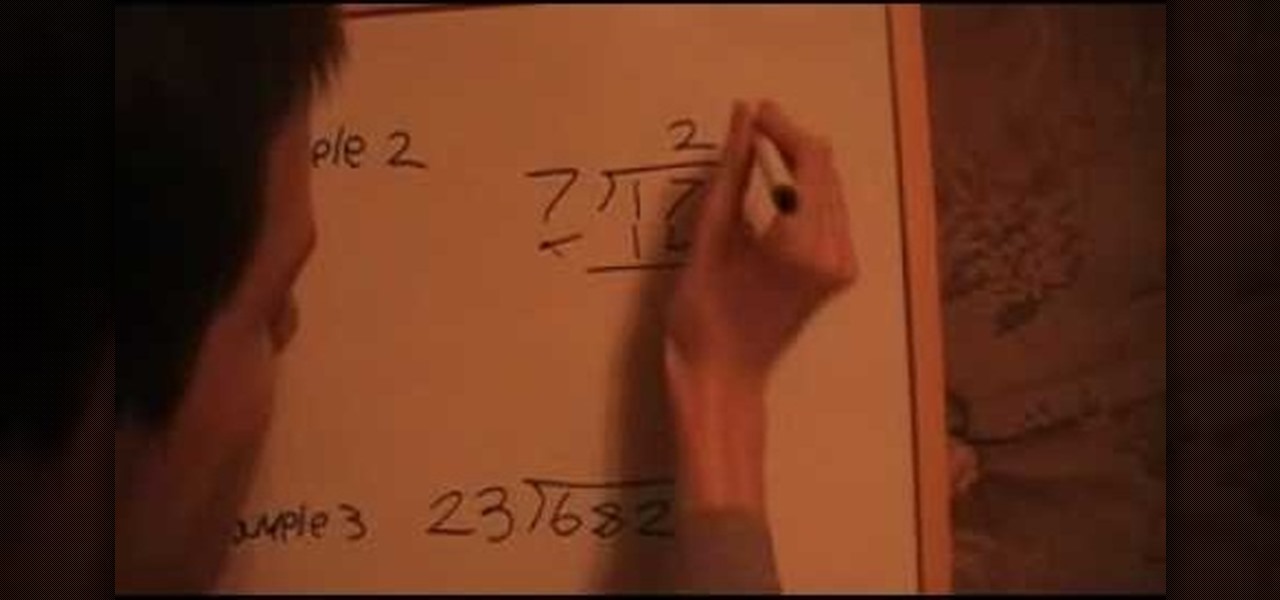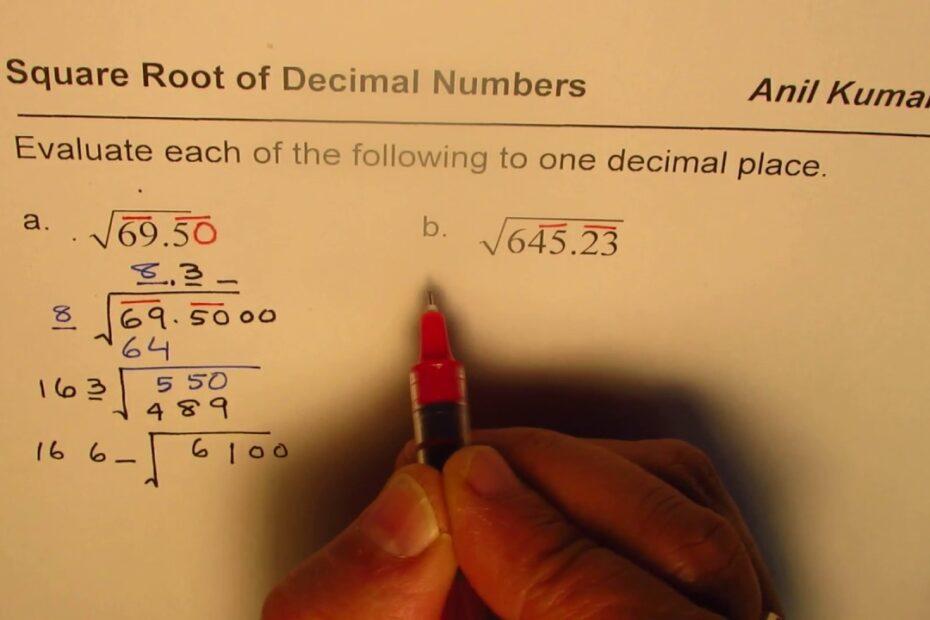To divide by decimals without a calculator, first move the decimal point of the divisor (the number on the bottom) to the right until it becomes a whole number. Then move the decimal point of the dividend (the number on top) to match it. Divide as you would with any whole numbers, and then move your answer’s decimal point back to its original position.
For example, if you wanted to divide 3.2 by 4.5 without a calculator: Move both 4.5 and 3.2 two places so that they become 45 and 32 respectively; 45 divided by 32 is 1 with remainder 13; Move the decimal in 1 two places back so that it becomes 0.13 which is your answer!
- Step 1: Estimate the answer
- Before you attempt to divide decimals without a calculator, it is important to have an idea of what the answer might be
- This will help make sure that your final result is accurate
- Step 2: Line up the decimal points and write down your problem
- Make sure both numbers are lined up so that their decimal points are in the same column
- This will make it easier to work through later on in the process
- Step 3: Divide as if there were no decimals present
- Since we are not using a calculator, we must do this step mentally or with pencil and paper depending upon how comfortable you feel with doing more complex math by hand
- Step 4: Count how many digits appear after each decimal point in both numbers being divided together, then add them together for a total number of places needed for accuracy in our answer’s decimal part
- For example, if one number has two digits after its decimal point when written out and another has three, then five (2 + 3) will be the total number of places needed for accuracy when writing out our answer’s fractional part
- Step 5: Write down your estimated answer from earlier along with all necessary zeroes behind its fractional part based off of the total number of places calculated during Step 4 above; this will give us an approximation which can later be refined as necessary before coming to a final conclusion
- Step 6: Start subtracting smaller numbers from larger ones until only one remains; continue dividing through mental multiplication and subtraction processes until arriving at a single digit remainder at bottom right corner – keep track of all carry-over remainders throughout entire process! Step 7: Compare results obtained from Steps 5 & 6 against each other – adjust estimated value accordingly until they match exactly; once satisfied with outcome write down final solution as well any additional information such as remainder values obtained throughout calculation process (if applicable)

Credit: math.wonderhowto.com
How Do You Divide Decimals Step by Step?
When it comes to dividing decimals, there are several steps you should follow in order to get the right answer. First, line up the decimal points of both numbers so that they’re directly across from each other. Then divide as if they were whole numbers while keeping track of where the decimal points are located.
After you’ve divided, place your answer’s decimal point directly above where the two original numbers’ decimal points lined up. Finally, don’t forget to add any additional zeros needed on either side before and after your answer’s decimal point based on how many digits there are after those same two original number’s decimals. With these simple steps in mind, you’ll be able to easily divide decimals with confidence!
What is the Easiest Way to Divide Decimals?
Dividing decimals can seem like a daunting task, but it doesn’t have to be! The easiest way to divide decimals is by using the long division method. To use this method, you will need to write out both numbers on either side of the decimal point separately.
Then, divide each number as if they were whole numbers (without the decimal) and place your answer above and below each number’s line respectively. Finally, move any digits from the dividend that are left over onto the next line in order for them to become part of the divisor before calculating again until all remaining lines are divided and solved for their remainder or quotient. With practice, dividing decimals can quickly become an easy process!
How Do You Divide Numbers Without a Calculator?
If you don’t have a calculator handy, there are many ways to divide numbers without one. One of the simplest methods is to use long division by hand. This involves breaking down a larger number into smaller parts and dividing each part in turn.
For example, if you wanted to divide 36 by 12, you would first write out 36 divided by 12 on paper: 36/12 = ?. Then, using your knowledge of multiplication and division facts up to at least twelve, break down the dividend (36) into multiples of twelve until it can be divided evenly; in this case that’s 24 + 12 = 36.
You then divide 12 into both 24 and 12 separately: 24/12 = 2 and 12/12 = 1. Finally, add up all of your answers – 2 + 1 = 3 – giving us our answer for 36/12 which is 3! Another method which works well for simple problems where the divisor does not exceed 10 is mental math or estimation techniques like ‘rounding up’ or ‘guess-and-check’.
So if we wanted to calculate 18 ÷ 6 quickly without writing anything down we could simply round 6 up to 10 – so now 18 ÷ 10 becomes 1 with 8 left over (18 – 10). Now 8 ÷ 6 gives us an easy answer of 1 with 2 left over (8 – 6). Adding these two together gives us our final answer of 18 ÷ 6 = 13 remainder 2!
How Do You Manually Divide Decimals by Decimals?
Dividing decimals by decimals can be a tricky concept to grasp, but with the right approach it’s easy. The key is to remember that you’re dealing with two different types of numbers: whole numbers and fractions. To manually divide decimals by decimals, start by changing both decimal numbers into fractions.
Then, invert the second fraction (also known as “flipping” it) and multiply the first fraction by this inverted fraction. This will give you your answer in its simplest form – a whole number plus any remainder expressed as another fraction. Remember to bring down any zeros from the original decimal if necessary before converting into fractions!
Once you have your final answer, convert back into its decimal form for easier understanding and use of your calculations!
How to DIVIDE DECIMALS Without Calculator | Using Long Division to Solve 1240.64/12.5 by Hand
Long Division With Decimal Remainders
Long division with decimal remainders is a method of dividing one number by another that yields an exact answer. This technique involves taking the dividend (the number to be divided) and divisor (the number used for division), performing long division, and writing the remainder as a decimal in the quotient. The process can help students better understand how decimals work in addition to teaching them how to divide efficiently.
How to Divide Decimals
When dividing decimals, it is important to remember that the divisor should always be a whole number. To do this, move the decimal places of both numbers so that the divisor becomes a whole number. Then place the decimal point in your answer directly above where you placed it in your dividend (the number you are dividing).
Finally, divide as normal and round off any extra digits after the decimal if necessary.
How to Divide Decimals by Whole Numbers
To divide a decimal by a whole number, first move the decimal point in both numbers to make the divisor (the whole number) a whole number. Then proceed with long division as you would with any other division problem. Once you have your answer, move the decimal point back so that it is in its original position – this will be the same number of places as there were digits after the decimal point in the dividend (the decimal).
How to Divide Decimals by Decimals
Dividing decimals by decimals is a simple process that requires converting the problem into fractions before solving. To divide two decimal numbers, take the first number and move its decimal point to make it a whole number. Then, divide this whole number by moving the second decimal’s point to make it a whole number as well.
Finally, convert your answer back into a decimal by counting how many places you moved each of the original numbers’ decimals and moving your answer’s decimal point in the same direction for an equal amount of digits.
Conclusion
In conclusion, dividing by decimals can be done without a calculator as long as you remember to use the traditional long division method and move the decimal point in both numbers. With practice, this process will become easier over time and you’ll soon be able to complete calculations quickly and accurately.
- The Power of Mobile Accessibility And Real-Time Tracking for Trucking Operations - November 6, 2024
- Why Ease of Use is Crucial in Trucking Dispatch Software - September 22, 2024
- Better Communication With Dispatchers: How Trucking Dispatch Software Can Optimize Operations - September 7, 2024

